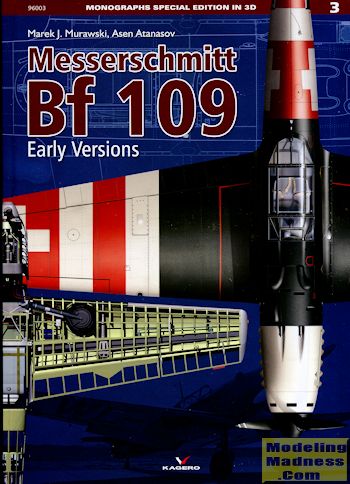 One of the
most well known and most built single engine fighters in the history of aviation
is the Bf-109. This is the airplane with which the Luftwaffe started WWII and it
was still being built when that conflict ended.
One of the
most well known and most built single engine fighters in the history of aviation
is the Bf-109. This is the airplane with which the Luftwaffe started WWII and it
was still being built when that conflict ended.|
Author: |
Marek Murawski & Asen Atanasov |
|
Publisher |
Kagero |
|
Price |
$39.95 from Casemate Publishing |
|
Reviewer: |
|
| Notes: | #96003. ISBN 978-83-64596-38-4, 190 pages, hardbound |
 One of the
most well known and most built single engine fighters in the history of aviation
is the Bf-109. This is the airplane with which the Luftwaffe started WWII and it
was still being built when that conflict ended.
One of the
most well known and most built single engine fighters in the history of aviation
is the Bf-109. This is the airplane with which the Luftwaffe started WWII and it
was still being built when that conflict ended.
The aircraft was the result of a fighter competition between Messerschmitt, Arado, Heinkel, and Focke-Wulf with only the Heinkel being a worthy adversary. However, as much press as has been given to the Heinkel, the truth is that the Messerschmitt design was faster, maneuvered better and was considerably less expensive to build. While the Heinkel 112 was successful to a small degree in the export market and probably could have been developed into a better aircraft, it is a fact that governments want the best they can get for as little money as they have to pay for something and so the Messerschmitt 109 went on into aviation history.
This book by Kagero is one of their few hard bound editions and covers all the early Jumo powered aircraft. Though the prototype was Rolls Royce powered, the rest of the A-D versions were powered by a Junkers engine. Over the years there has been debate as to the existence of a Bf-109A variant. However, it seems that this is the version first sent to Spain and there were actually several dozen constructed. Another piece of information is that there never was a 109B-2 version. All were B-1s and there was simply a change from the wooden to the metal prop early in the production of this type. The first one to have wing guns was the 109C-1. The C-3 variant had two cannon in the outer wings but few of these were constructed. The vast majority of Jumo powered 109s were of the D-1 variant and many of those saw combat in the first six months of the war before sufficient Daimler-Benz powered 109E-1/3 versions were available to replace them.
We start out with the fighter competition of 1935 and then move on to the prototypes and their participation in various aviation events before the war. It is here that we learn about a special 109 that was built just for the air speed record. It then goes into the combat history of the plane. A goodly portion of this section is devoted to its operations in the Spanish Civil War where it was used quite effectively. Later its use in the Polish campaign and in the Sitzkrieg of 1939/1940 is covered.
There are sections that provide differences between the variants, sections that cover camouflage, sections that have plans of all the versions in 1/72 and 1/48 scale, sections that use 3D artwork to show not only the airframes of different versions, but also cutaways. Then there are pages for the all the detail bits like interiors, engine, landing gear and so on. This all comes to a conclusion with several pages of large full color profiles and other art work.
It all makes for an excellent book on the early 109. A book with a lot of great period photographs of planes and personalities. A book in which most readers will learn something they did not know. A book that is a must for the 109 enthusiast and one that I can quite easily recommend to you.
Copyright ModelingMadness.com October 2015
My thanks to Casemate Publishing for the review sample. Visit them at Casemate Publishing and order yours, or get them at your favorite hobbyist.
If you would like your product reviewed fairly and fairly quickly, please contact me or see other details in the Note to Contributors.